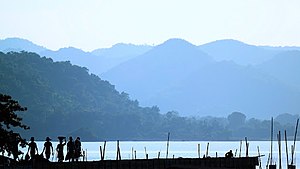Mayurakshi River
| Mayurakshi River | |
|---|---|
 Mayurakshi River near Dumka | |
| Location | |
| Country | |
| Location | Jharkhand, West Bengal |
| Physical characteristics | |
| Source | |
| • location | Trikut Hill, Deoghar district, Jharkhand |
| Length | 250 km (160 mi) |
| Discharge | |
| • location | Bhagirathi River, Murshidabad district, West Bengal |
| Basin features | |
| Tributaries | |
| • right | Brahmani, Dwaraka, Bakreswar and Kopai |
Mayurakshi River (also called Mor River) is an important river in Indian states of Jharkhand and West Bengal.
Etymology[edit]
The word means,in Indian laguages, "eye of the peacock", mayur/mor means peacock and Akshi is eye.[1][2]
Geography[edit]
Mayurakshi River originates from the Trikut Hill, about 16 km (10 miles) away from Deoghar.[1] It flows for 250 km (160 miles) through the Deoghar and Dumka districts in Jharkhand and Birbhum and Murshidabad districts of West Bengal before joining the Bhagirathi.[2]
The Mayurakshi River Basin covers 9,596 sq km.[3]
The tributaries of the Mayurakshi River are: Brahmani, Dwaraka, Bakreswar and Kopai rivers.[1]
In Boatman Tarini, Tarasankar Bandyopadhyay, the eminent author, wrote, “The Mayurakshi is famous for its strong current. For seven or eight months in the year the river is a desert – sands stretching from shore to shore for a mile and a half. But when the rains come, she is terrible, demoniac. She races along, four to five miles wide, her deep grey water swamping everything within reach. Then comes once in a while the Harpa flood, when the water, six to seven cubits deep, rushes into villages nearby and washes away homes and granaries and all else in its way. This does not happen very often though.” [4]
Floods[edit]
Floods are a recurring feature and the Mayurakshi river basin is one of the most flooded areas in the country.[3]
Many storm-fed rivers on the Chota Nagpur Plateau flow down into West Bengal and cause devastating floods. That is so true for the Mayurakshi. For ages the Mayurakshi has been causing havoc in its basin. “Annual rainfall in this basin varies between 765 and 1,607 mm (30 to 63 inches) with an average precipitation of 1,200 mm (47 inches), 80% of which occurs during the monsoon season from June to September.” [1]
In 1978, with 72 hours of heavy rainfall, the floods caused by all rivers from the Bansloi to the Ajay washed away the eastern bank of the Bhairathi causing enormous damage in the Nadia, Murshidabad and North 24 Paganas districts. It was followed by floods in 1998, 1999 and 2000.[1]
Floods in the Damodar-Ajay-Mayurashi system are well known and affect the lives of people. It must be noted that in addition to the causes noted above, drainage congestion is another reason for the floods. Anthropogenic activities like construction of barrages, embankments and sand mining have an effect on the intensity and frequency of floods, particularly of the Dwaraka, a tributary of the Mayurakshi, which itself is adding to the adverse effects with channel derangement. Flood frequency in the Mayurakshi basin has increased with the construction of the Tilpara barrage. Based on a 75-year old data about rainfall and floods, it is observed that “flood of Lower Mayurakshi River has changed its character from the high magnitude low-frequency event to low magnitude high-frequency event due to controlled river regime by dams and barrages”.[3]
Massanjore Dam[edit]
From the counterpart rupee fund created through supplies of wheat and other materials from Canada for use in India, Canada devoted those rupees to the further development of the Mayurakshi dam project. Lester B. Pearson, foreign minister of Canada inaugurated the Massanjore Dam in 1956. The 47 meters (155 feet) high and 660 meters (2,170 feet) long dam has a reservoir that covers an area of 67.4 sq km (16,650 acres) when full and has a storage capacity of 617 million cubic meters (500,210 acre feet).[1]
Tilpara Barrage[edit]
It is located near Suri and is 309 meters (1,013 ft) long.[1] It has a catchment of 3,208 sq km. The main canal on the left is 16.62 km long and that on the right is 22.53 km long. These irrigate 2,26,629 Ha of the Kharif crop and 20,250 Ha of the Rabi crop in the Birbhum, Purba Badhaman and Murshidabad districts.[5]
Other weirs/ barrages in this basin are the Bakreswar Weir, Kopai Barrage, Dwaraka Weir and Brahmani Barrage.[5]
Irrigation and Power Generation[edit]
Massanjore dam has resulted in the irrigation of some 600,000 acres (2,400 km²) and generation of 2,000 kW of electric power.[6]
See also[edit]
Coordinates: 24°29′00″N 86°42′00″E / 24.483333°N 86.700000°E
References[edit]
- ↑ 1.0 1.1 1.2 1.3 1.4 1.5 1.6 "Mayurakshi River". Academic Accelerator. Retrieved 12 July 2023.
- ↑ 2.0 2.1 "Mayurakshi River Deoghar-Massanjore Dam". Updated 5 July 2023. Deoghar. Retrieved 12 July 2023.
- ↑ 3.0 3.1 3.2 "Drainage basin morphometry and evaluating its role in flood-inducing capacity of tributary rivers of Mayurakshi River, India". Aznarul Islam & Suman Deb Barman. Springer Link. Retrieved 12 July 2023.
- ↑ Boatman Tarini, translated by Hilren Mukerjee. Contemporary Indian Short Stories, Series II, Sahitya Akademi.
- ↑ 5.0 5.1 "Irrigation Section". Tilpara Barrage. Irrigation and Waterways department, Goovernment of West Bengal. Retrieved 12 July 2023.
- ↑ "Mayurakshi River". Irrigation and Power. liquisearch. Retrieved 13 July 2023.



